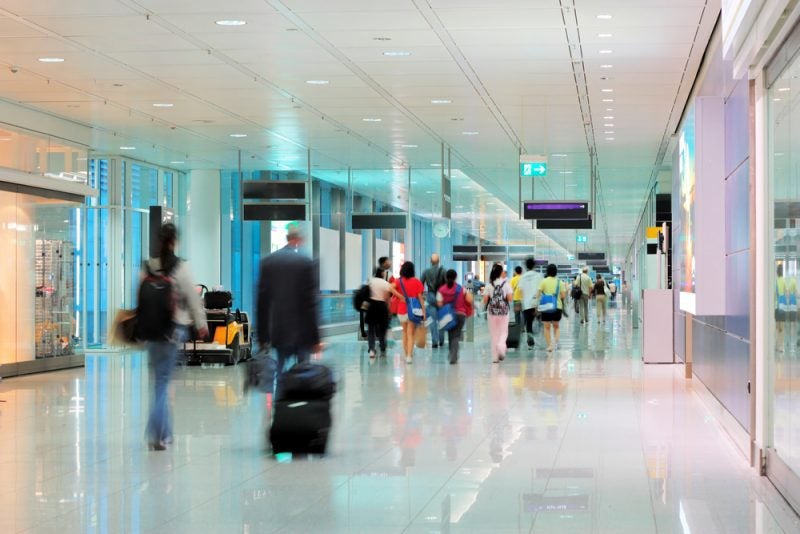
As air travel becomes increasingly affordable, there are more people taking to the skies than ever before. And the trend is showing no signs of slowing down, with the International Air Transport Association (IATA) recently revealing that passenger numbers could double to 8.2 billion by 2037.
With this growth comes great potential for airports and the retailers they accommodate. After all, this mutually beneficial relationship provides retailers with a captive audience and airports with approximately two-fifths of their overall revenue via non-aeronautical activities.
Thanks to the latest advancements in technology, making the most of this upsurge in passenger traffic has never been easier.
A captive audience
“Transport hubs, especially large transport hubs, are effectively retail spaces,” says Howard Holton, CTO at leading data technology firm Hitachi Vantara. “Modern airports are basically malls that use airplanes to take people in and out.
“But the value a transport hub has for retail is it’s dealing with a generally captive audience. We’re asked to show up two hours before our plane takes off for international flights and a minimum of an hour before for domestic, plus there are often travellers experiencing long layover times. Similarly, people tend to arrive early at bus terminals, train stations and ports. They need to kill time.”
With so much potential, how can airports and retailers collaborate to improve the travel experience and subsequently maintain and even increase spending at outlets? According to Holton, the answer lies in smarter shopping, as driven by data and analytics.
“What consumers are really looking for is a more personalised experience. Hitachi Vantara is now able to capture data that airports previously could not, such as monitoring what passenger traffic looks like and tracking that experience as people move throughout the airport, which means we can personalise the traveller’s journey.”
Actionable insights
Solutions such as Hitachi Smart Spaces provide transport hubs with access to actionable insights that allow operators to optimise the shopping experience in terminals. This integrated view of passenger activity, operations and safety issues allows officials to make faster, better informed decisions through a map-based, single-pane perspective. It combines real-time video from cameras, facilities data from building systems and IoT sensors, analytics tools, social media and smart devices.
This combination of technology and data supports smarter, more efficient airport and port operations. They enable data to be blended, analysed and visualised through key insights such as visitor activity analysis, queue detection, vehicle counting, people counting, and flow of foot traffic. But the real value is derived when operators use this information to take proactive actions and customise the passenger experience in the physical world, similar to how they already do digitally for online stores and e-commerce.
“A smart sign is great,” says Holton. “But it only allows you to change the display. A smart sign tied into airline data and video analytics, however, allows you to see that a plane has just landed from Shanghai, for example, and then make an educated guess on what language the majority of passengers will speak, and adjust the advert’s language accordingly. Then do the same thing in 15 minutes when the plane from Frankfurt lands.
“Now we are able to speak to people in their language, targeting ads to the demographic without getting too invasive. It also means airports can sell those targeted ads at a much higher rate. So penetration improves and ad value increases. It’s also possible to re-sell that same space multiple times and be more effective than before.”
But that’s not all. Hitachi has a whole suite of products that fall into the ‘smart spaces’ vertical, giving operators access to as much or as little analytics as they desire. What’s more, it’s all achieved as an overlay to the existing system.
According to Holton: “We use existing cameras and NVRs, layering video intelligence on top and working with the operational team to determine their current workflow and how we can work within it.
“We know that the most expensive resource today is people, so we want to increase the productivity of the people cost and enable these additional capabilities and features in a way that is as seamless as possible. We don’t want these new processes to be a heavy burden.”
Redefining travel
As airports continue to evolve, these advancements in technology will play an increasing role in the future of transport hub retail. The emergence of smart airports are redefining travel, with capabilities such as paperless boarding making many aspects of the passenger journey simpler than ever before.
And plans for future airports look set to take this convenience even further, with indoor gardens, touchscreen shopping and even virtual assistants being pitted as the next big thing in transport hubs.
When it comes to retail, the future is looking just as bright, with smart solutions like those from Hitachi Vantara, working towards improving the travel experience for airports, retailers, and customers.


